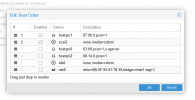kvm: -device vfio-pci,host=07:00.0,id=hostpci3,bus=ich9-pcie-port-4,addr=0x0,bootindex=50: Bus 'ich9-pcie-port-4' not found
start failed: command '/usr/bin/kvm -id 105 -name amb47workstation -chardev 'socket,id=qmp,path=/var/run/qemu-server/105.qmp,server,nowait' -mon 'chardev=qmp,mode=control' -chardev 'socket,id=qmp-event,path=/var/run/qemu-server/105-event.qmp,server,nowait' -mon 'chardev=qmp-event,mode=control' -pidfile /var/run/qemu-server/105.pid -daemonize -smbios 'type=1,uuid=abd2ccad-4438-490d-aa22-0e74baf471cb' -drive 'if=pflash,unit=0,format=raw,readonly,file=/usr/share/pve-edk2-firmware//OVMF_CODE.fd' -drive 'if=pflash,unit=1,format=raw,id=drive-efidisk0,file=/dev/zvol/rpool/data/vm-105-disk-0' -smp '8,sockets=1,cores=8,maxcpus=8' -nodefaults -boot 'menu=on,strict=on,reboot-timeout=1000,splash=/usr/share/qemu-server/bootsplash.jpg' -vga none -nographic -no-hpet -cpu 'host,+kvm_pv_unhalt,+kvm_pv_eoi,hv_vendor_id=proxmox,hv_spinlocks=0x1fff,hv_vapic,hv_time,hv_reset,hv_vpindex,hv_runtime,hv_relaxed,hv_synic,hv_stimer,kvm=off' -m 8192 -device 'vfio-pci,host=07:00.0,id=hostpci3,bus=ich9-pcie-port-4,addr=0x0,bootindex=50' -readconfig /usr/share/qemu-server/pve-q35.cfg -device 'usb-tablet,id=tablet,bus=ehci.0,port=1' -device 'vfio-pci,host=03:00.0,id=hostpci0.0,bus=ich9-pcie-port-1,addr=0x0.0,multifunction=on' -device 'vfio-pci,host=03:00.1,id=hostpci0.1,bus=ich9-pcie-port-1,addr=0x0.1' -device 'vfio-pci,host=00:1b.0,id=hostpci1,bus=ich9-pcie-port-2,addr=0x0' -device 'vfio-pci,host=00:14.0,id=hostpci2,bus=ich9-pcie-port-3,addr=0x0' -chardev 'socket,path=/var/run/qemu-server/105.qga,server,nowait,id=qga0' -device 'virtio-serial,id=qga0,bus=pci.0,addr=0x8' -device 'virtserialport,chardev=qga0,name=org.qemu.guest_agent.0' -iscsi 'initiator-name=iqn.1993-08.org.debian:01:f630670652' -drive 'if=none,id=drive-ide0,media=cdrom,aio=threads' -device 'ide-cd,bus=ide.0,unit=0,drive=drive-ide0,id=ide0' -netdev 'type=tap,id=net0,ifname=tap105i0,script=/var/lib/qemu-server/pve-bridge,downscript=/var/lib/qemu-server/pve-bridgedown,vhost=on' -device 'virtio-net-pci,mac=B6:5F:55:91:78:39,netdev=net0,bus=pci.0,addr=0x12,id=net0' -rtc 'driftfix=slew,base=localtime' -machine 'type=q35' -global 'kvm-pit.lost_tick_policy=discard'' failed: exit code 1




